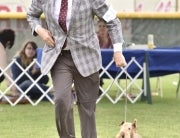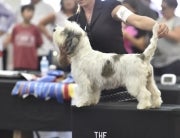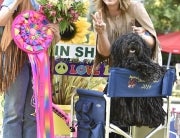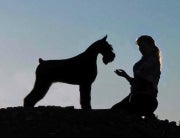By Stephanie Abraham, American Boxer Club, from the April 2016 AKC Gazette
Two people stepped into the Boxer world during the 1960s and ’70s who would later become icons of the breed. They both passed away in 2015, each leaving behind a legacy of immense talent as breeders and a lifelong commitment to dogs that ensures they will not soon be forgotten. One was an owner-handler, and the other was never surpassed in decades as a professional handler of all breeds.
The life paths of Jane Kamp Forsyth and Theodore (“Ted”) Fickes crossed many times.
The Girl From Gray Street
Jane, born in 1929, lived as a girl on Gray Street in Arlington, Massachusetts. She was born into a world of dogs: Her mother was a breeder of Boxers and Airedales, as Grayarlin Kennels.
Jane chose the Boxer as her first love. When she became a professional handler, she went into partnership with George Pusey, continuing Grayarlin in Holliston, Massachusetts. Together they became the top Boxer breeders in the U.S. for three years, and they helped many novices on the road to successful breeding programs of their own.
Perhaps the most well known of these novices were Phyllis and Dan Hamilburg of Brookline, Massachusetts. In 1952, Jane sold them Sally of Grayarlin as a beloved pet for their children but wound up handling her to her title.
Sally was bred twice but never produced a show prospect, then the Hamilburgs bought Sabot and his sister Slipper of Grayarlin. Slipper became arguably their most influential producer through her famous son Ch. Salgray’s Battle Chief and his six-champion “F” litter.
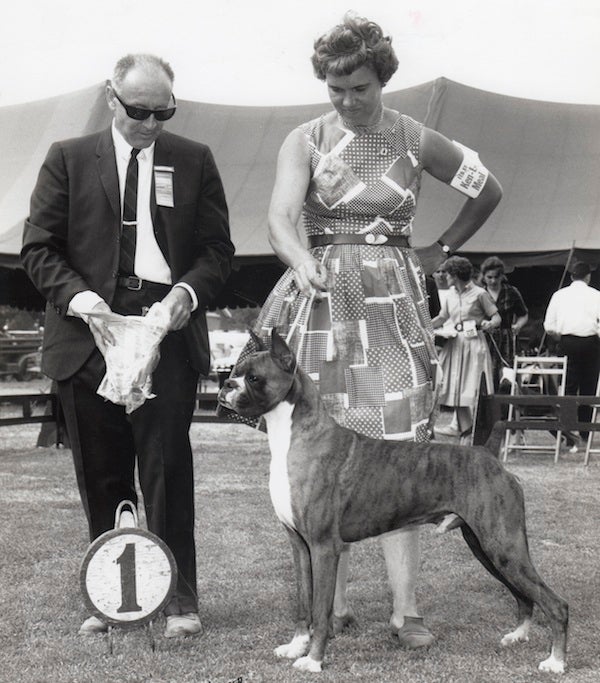
Ch. Salgray’s Flying High, LOM, one of the famous “F” litter of six champions sired by Ch. Salgray’s Battle Chief and bred by Phyllis and Dan Hamilburg of Brookline, Massachusetts, shown by Jane Kamp (Forsyth) at the Middlesex Boxer Club Specialty, May 31, 1964, with breeder-judge Ralph Meshon. Flying High was awarded the American Boxer Club’s Legion of Merit and was the sire of 27 champions. (Photo courtesy Janie Hamilburg Guy)
Though many of the Salgray dogs were handled by Stan Flowers and Larry Downey, Jane remained very influential in the Salgray breeding program and campaigned a number of the Hamilburg dogs to their titles and beyond.
Ted Fickes: A Lifelong Love of Boxers
Ted Fickes, born in 1940, was raised in Leetonia, Ohio, and graduated from Ohio State veterinary school. He bred his first litter of Boxers in 1957 while still in high school and bought his foundation bitch, Nahum’s Arriba, while a student at Ohio State. She was the daughter of Ch. Sigro’s Fury, whom Ted maintained was the typiest bitch he ever saw. From “Riba” bred to Ch. Mazelaine’s Early Times came the three bitches Amulet, Anonymous, and Alicia, who are behind almost every subsequent Arriba champion.
Ted’s first job after graduation brought him to a veterinary practice north of Boston, and there he continued his Arriba Boxer breeding program, always striving for quintessential breed type. When Ted arrived in Massachusetts to set up his practice, he had a pregnant Boxer bitch with him and was living in a small house with four other people. He couldn’t whelp her there, so he called Phyllis in desperation—even though he did not know her. She found someone to whelp that litter for him, and thus began a lifelong relationship.
Crossing Paths
By this time, as the stylish and beautiful Salgray dogs won far and wide, Jane was handling for the Hamilburgs on a regular basis, and Ted became good friends with Phyllis and Dan (and later their daughter Janie). They were all at ringside at almost every show in the Northeast, and of course Phyllis introduced Ted to Jane, and thus began a friendship that was to endure for their entire lives.
Jane began to handle for Ted, telling him she couldn’t stand to see him ruin a dog with his amateur handling—and she teased him about this whenever the occasion arose! Her eventual campaign of Ch. Arriba’s Prima Donna (“Suzie”) included her Best of Breed win at the American Boxer Club national in 1969, and culminated in her spectacular Best in Show at Westminster in 1970—still the only Boxer bitch to achieve this honor. Best in Show judge Anna K. Nicholas called Suzie “elegance personified, a perfectly beautiful working dog.”
Ted, at the advanced age of 29, could be proud of a fledgling breeding program that had produced a Westminster BIS winner out of one of his homebred bitches. Even better, Suzie was healthy and long-lived, passing away at 14.
Ted never stopped breeding beautiful Boxers, and although he chose not to climb the judging ladder, he did judge many sweepstakes and the American Boxer Club Futurity and Top Twenty events.
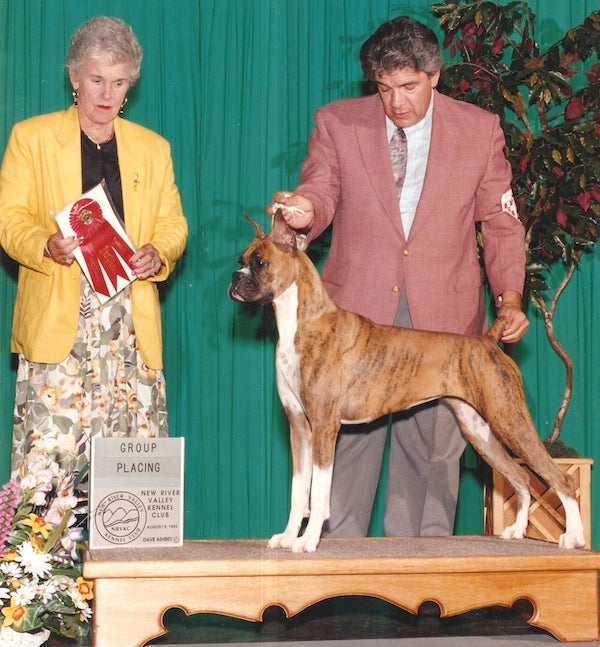
Jane Forsyth awarding Group 2 to Ch. Talisman Arriba Sonata, breeder-owner-handled by Ted Fickes at New River Valley KC in 1993. (Photo courtesy Virginia Shames)
Jane: A Legend in the Sport
We all recognize the immense talent of Jane Forsyth in the show ring. She was designated Kennel Review Handler of the Year three times. She had “those hands” that could effortlessly mold a mediocre dog into a good one, and a good dog into a memorable one. When she handled a great one, it became one for the ages—whether Prima Donna or the brilliant Afghan Mrs. Cheever Porter’s Ch. Holly Hill Desert Wind, or the Gordon Setter Ch. Legend of Gael, or the Boxers Ch. Flintwood’s Rabble Rouser and Mrs. Jouett Shouse’s Bang Away son, Ch. Barrage of Quality Hill—to mention a few.
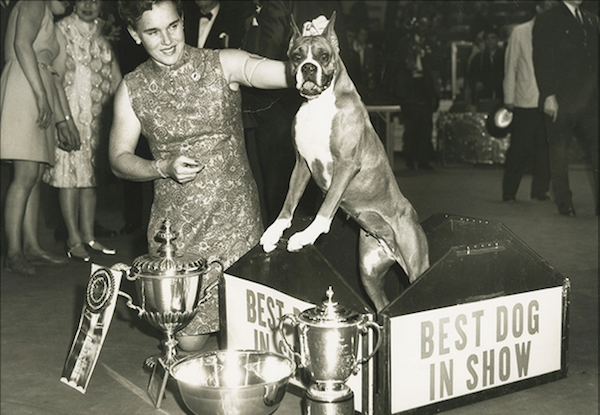
Jane Forsyth with Ch. Arriba’s Prima Donna, Best in Show at Westminster in 1970. (Jane and her husband Bob are the only husband and wife to each win Best in Show at Westminster as handlers; Bob won in 1964 with the Whippet Ch. Courtenay Fleetfoot of Pennyworth.)
While Jane’s business sense demanded diversity in the breeds she handled, Boxers always remained her favorites. Together she and her husband Bob were as close to a “handler dynasty” as one could find.
In 1981, Jane retired from handling to begin a distinguished judging career. Among her many exciting assignments, she had been looking forward to judging Best in Show at Morris and Essex in October 2015, but sadly it was not to be.
Two Great Mentors
Neither Ted nor Jane “suffered fools gladly,” which is probably one of the many reasons they got along so well. They both spoke their mind, and each could appear very intimidating to the uninitiated (Jane especially). Janie Hamilburg-Guy remembers Jane soundly chastising her as a child for running around the dog crates and disturbing the dogs on a show circuit. But both Ted and Jane were kind at heart and always ready to help and advise the younger Boxer enthusiasts just coming up in the ranks.
I remember being at a party in the early 1970s at the home of Vic and Nini Clemente and was so surprised to see Jane turn to Ted and say, “You take care of these people”—meaning my husband David and myself, who were just starting out. We were thrilled! Such seminal moments in the lives of young enthusiasts helped to shape decades of breeding to come. Jane respected those who really wanted to learn and was generous with good advice, often concentrating less on pedigree but emphasizing complementary breed type, a philosophy that Ted shared.
Oh, to be able to recreate those lively discussions at Ted’s house, dog photos and magazines spread out on the floor, breeder friends agreeing and disagreeing at will. As Tami Mishler, longtime Boxer breeder and handler wrote, “Ted was always the most popular guy in the room. When you sat and talked with him, he had the skill to make you feel as though you were the most important and interesting person there.”
If Ted and Jane had been Broadway stars, the lights on the Great White Way would have dimmed out of respect for their passing. All of us in Boxers owe them a great debt, because each in their own way helped to shape the Boxer as he is today. Their influence was felt far beyond Boxers, however. They transcended one specific breed because they earned the respect of almost every serious “dog person” they encountered, and they never stopped speculating about what might happen if a certain bitch was put to a certain stud dog. Ted, in fact, was actively breeding in partnership with Virginia Shames until his final illness, having finished over 100 AKC champions, many of whom went on to be great producers—including 10 Sires of Merit, 12 Dams of Merit, and one Legion of Merit sire. Ted won his final American Boxer Club Best of Breed with Ch. Arriba Talisman Satisfaction in 2007.
There will be other great breeders, and perhaps someone almost as talented as Jane in the ring, but I doubt we will see their paths cross in quite the same way as did Jane and Ted’s—each enriching the other, the dog world at large, and especially the breed to which they remained selflessly devoted all their lives. Though they each lived into what some might term “ a good age,” they both left us far too soon. —Stephanie Abraham, landmarks.properties@snet.net
An earlier version of this article appeared in Dog News.
Watch this year’s Boxer entry at Westminster:



